Exploring Transactional Communication's Impact on Staff Motivation
VerifiedAdded on 2023/06/11
|10
|2376
|399
Literature Review
AI Summary
This literature review examines the impact of transactional communication on staff motivation, drawing upon Barnlund's Transactional Communication Theory and Alderfer's ERG Theory. Barnlund's model emphasizes the reciprocal nature of communication, highlighting the importance of sender and receiver roles, environmental factors, and feedback. Alderfer's ERG theory focuses on existence, relatedness, and growth needs as motivators for employees, which can be addressed through transactional communication strategies like contingent rewards and active management. The review also considers the roles of passive management and laissez-faire leadership within transactional communication, emphasizing the need for understanding and addressing employees' individual needs to foster motivation and improve organizational performance. The document provides a detailed analysis of these theories and their practical implications for enhancing staff motivation through effective communication practices.
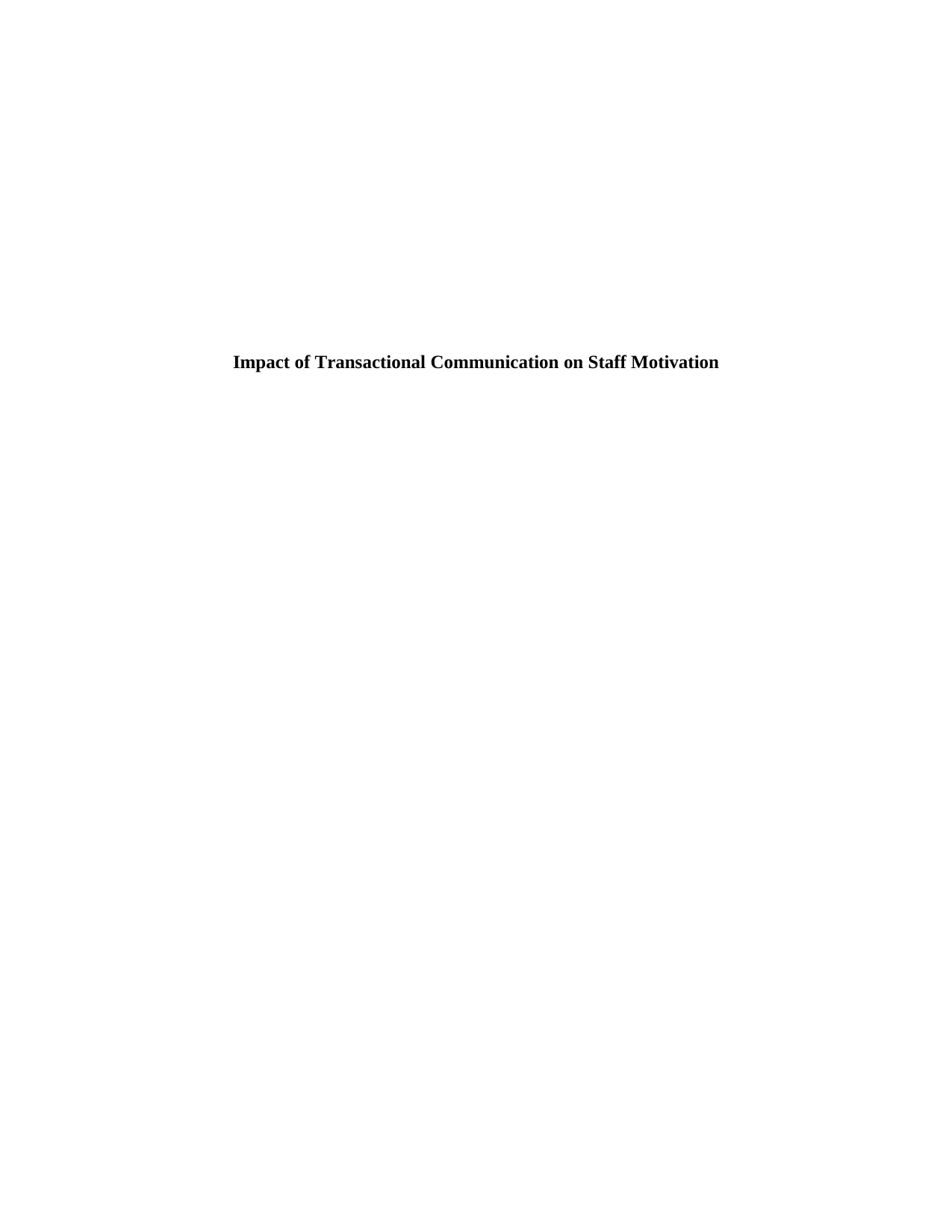
Impact of Transactional Communication on Staff Motivation
Paraphrase This Document
Need a fresh take? Get an instant paraphrase of this document with our AI Paraphraser
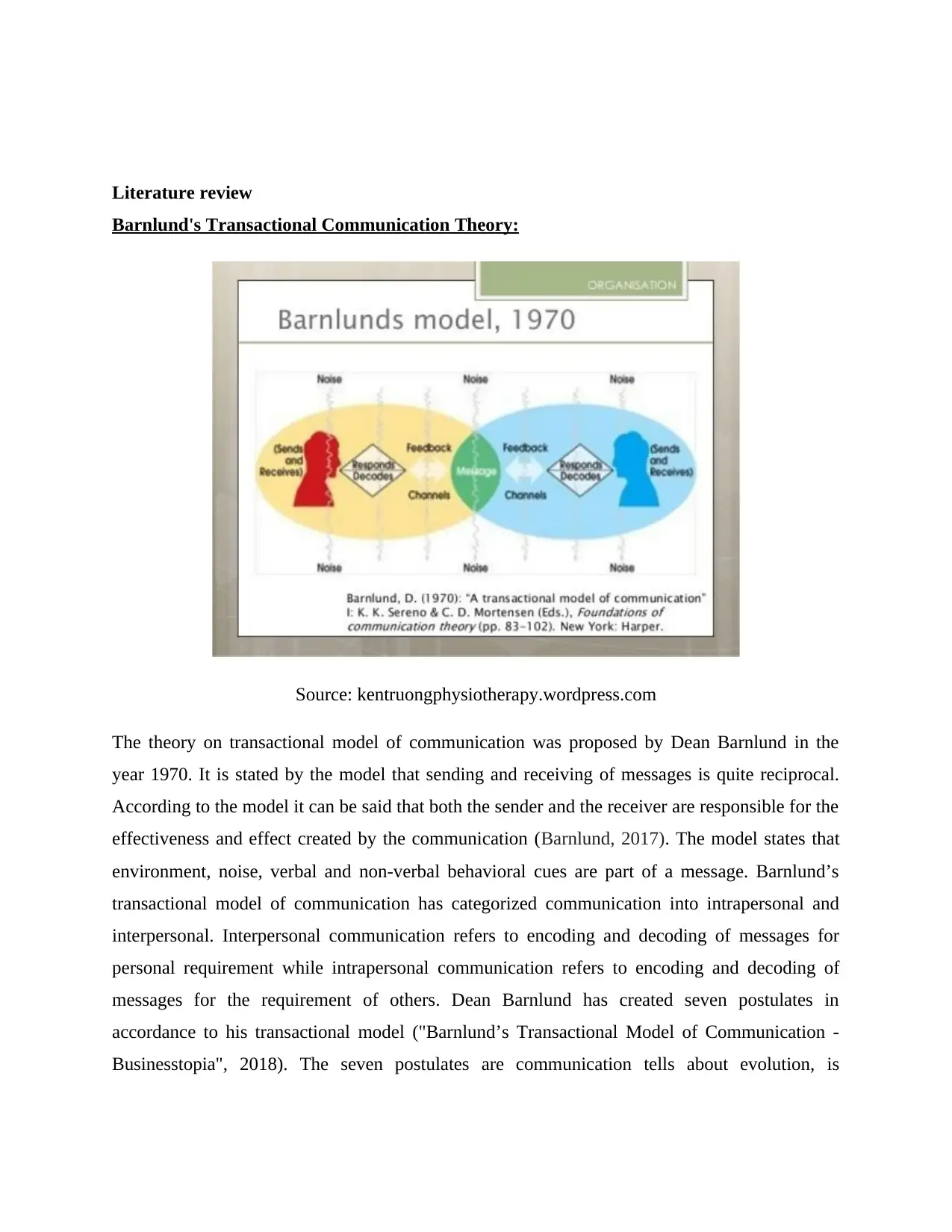
Literature review
Barnlund's Transactional Communication Theory:
Source: kentruongphysiotherapy.wordpress.com
The theory on transactional model of communication was proposed by Dean Barnlund in the
year 1970. It is stated by the model that sending and receiving of messages is quite reciprocal.
According to the model it can be said that both the sender and the receiver are responsible for the
effectiveness and effect created by the communication (Barnlund, 2017). The model states that
environment, noise, verbal and non-verbal behavioral cues are part of a message. Barnlund’s
transactional model of communication has categorized communication into intrapersonal and
interpersonal. Interpersonal communication refers to encoding and decoding of messages for
personal requirement while intrapersonal communication refers to encoding and decoding of
messages for the requirement of others. Dean Barnlund has created seven postulates in
accordance to his transactional model ("Barnlund’s Transactional Model of Communication -
Businesstopia", 2018). The seven postulates are communication tells about evolution, is
Barnlund's Transactional Communication Theory:
Source: kentruongphysiotherapy.wordpress.com
The theory on transactional model of communication was proposed by Dean Barnlund in the
year 1970. It is stated by the model that sending and receiving of messages is quite reciprocal.
According to the model it can be said that both the sender and the receiver are responsible for the
effectiveness and effect created by the communication (Barnlund, 2017). The model states that
environment, noise, verbal and non-verbal behavioral cues are part of a message. Barnlund’s
transactional model of communication has categorized communication into intrapersonal and
interpersonal. Interpersonal communication refers to encoding and decoding of messages for
personal requirement while intrapersonal communication refers to encoding and decoding of
messages for the requirement of others. Dean Barnlund has created seven postulates in
accordance to his transactional model ("Barnlund’s Transactional Model of Communication -
Businesstopia", 2018). The seven postulates are communication tells about evolution, is
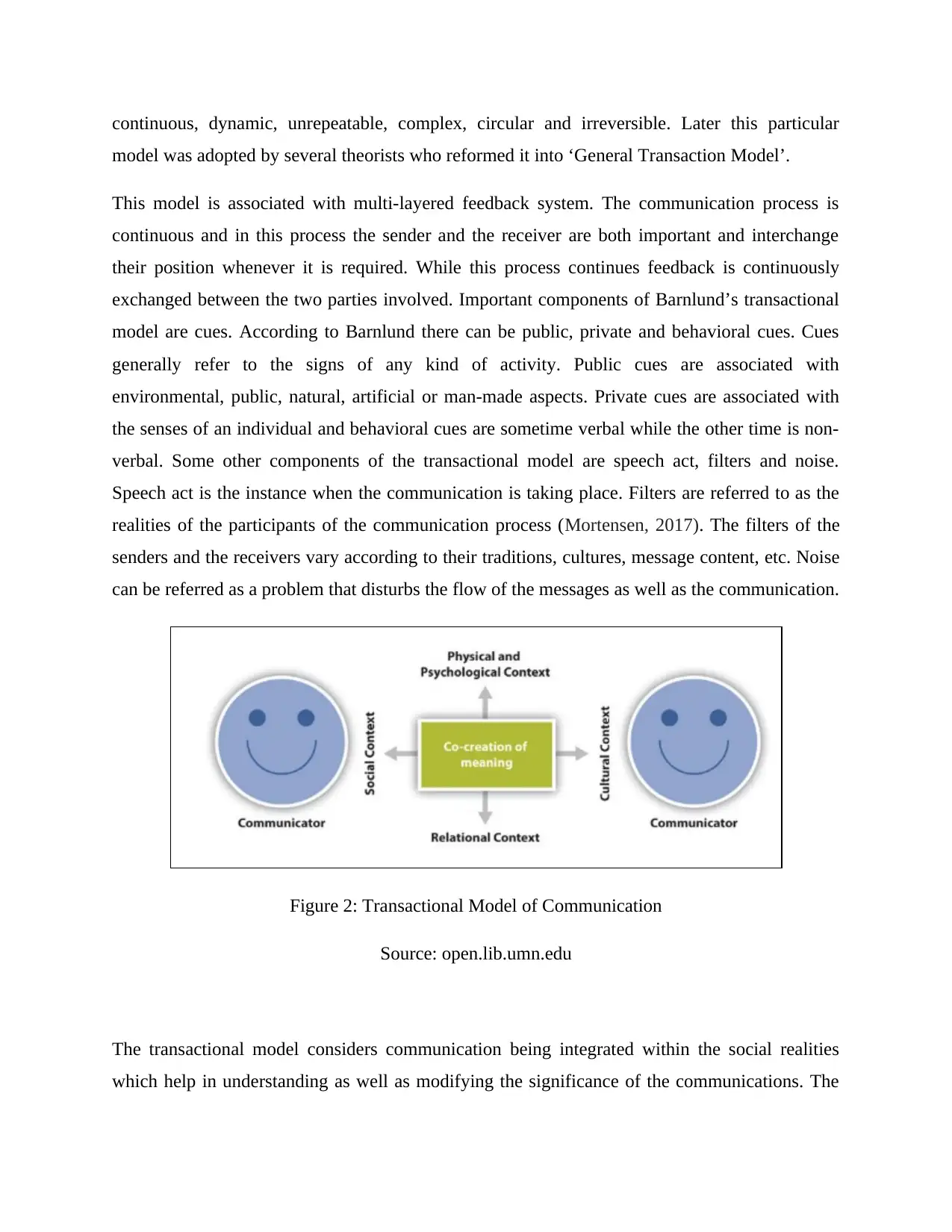
continuous, dynamic, unrepeatable, complex, circular and irreversible. Later this particular
model was adopted by several theorists who reformed it into ‘General Transaction Model’.
This model is associated with multi-layered feedback system. The communication process is
continuous and in this process the sender and the receiver are both important and interchange
their position whenever it is required. While this process continues feedback is continuously
exchanged between the two parties involved. Important components of Barnlund’s transactional
model are cues. According to Barnlund there can be public, private and behavioral cues. Cues
generally refer to the signs of any kind of activity. Public cues are associated with
environmental, public, natural, artificial or man-made aspects. Private cues are associated with
the senses of an individual and behavioral cues are sometime verbal while the other time is non-
verbal. Some other components of the transactional model are speech act, filters and noise.
Speech act is the instance when the communication is taking place. Filters are referred to as the
realities of the participants of the communication process (Mortensen, 2017). The filters of the
senders and the receivers vary according to their traditions, cultures, message content, etc. Noise
can be referred as a problem that disturbs the flow of the messages as well as the communication.
Figure 2: Transactional Model of Communication
Source: open.lib.umn.edu
The transactional model considers communication being integrated within the social realities
which help in understanding as well as modifying the significance of the communications. The
model was adopted by several theorists who reformed it into ‘General Transaction Model’.
This model is associated with multi-layered feedback system. The communication process is
continuous and in this process the sender and the receiver are both important and interchange
their position whenever it is required. While this process continues feedback is continuously
exchanged between the two parties involved. Important components of Barnlund’s transactional
model are cues. According to Barnlund there can be public, private and behavioral cues. Cues
generally refer to the signs of any kind of activity. Public cues are associated with
environmental, public, natural, artificial or man-made aspects. Private cues are associated with
the senses of an individual and behavioral cues are sometime verbal while the other time is non-
verbal. Some other components of the transactional model are speech act, filters and noise.
Speech act is the instance when the communication is taking place. Filters are referred to as the
realities of the participants of the communication process (Mortensen, 2017). The filters of the
senders and the receivers vary according to their traditions, cultures, message content, etc. Noise
can be referred as a problem that disturbs the flow of the messages as well as the communication.
Figure 2: Transactional Model of Communication
Source: open.lib.umn.edu
The transactional model considers communication being integrated within the social realities
which help in understanding as well as modifying the significance of the communications. The
⊘ This is a preview!⊘
Do you want full access?
Subscribe today to unlock all pages.

Trusted by 1+ million students worldwide
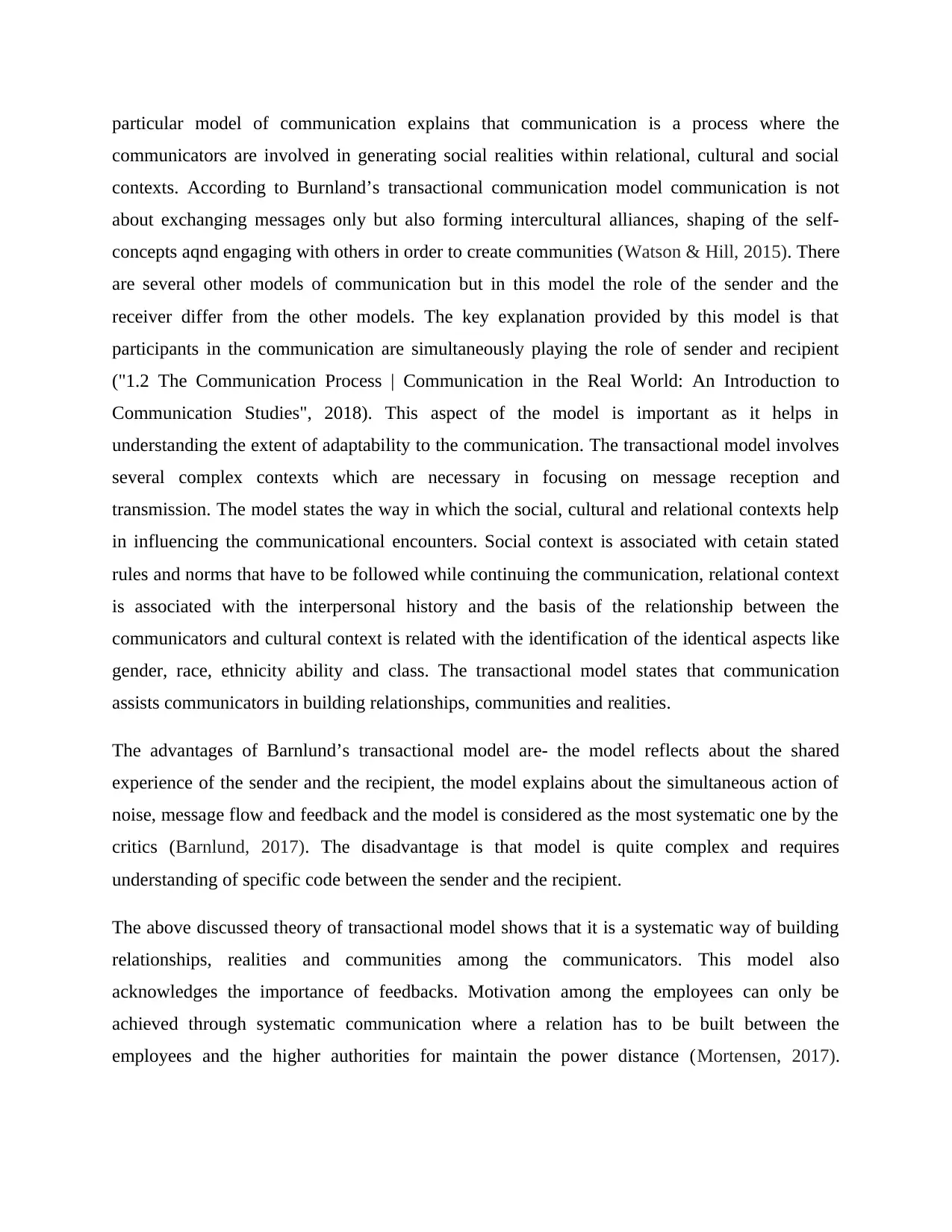
particular model of communication explains that communication is a process where the
communicators are involved in generating social realities within relational, cultural and social
contexts. According to Burnland’s transactional communication model communication is not
about exchanging messages only but also forming intercultural alliances, shaping of the self-
concepts aqnd engaging with others in order to create communities (Watson & Hill, 2015). There
are several other models of communication but in this model the role of the sender and the
receiver differ from the other models. The key explanation provided by this model is that
participants in the communication are simultaneously playing the role of sender and recipient
("1.2 The Communication Process | Communication in the Real World: An Introduction to
Communication Studies", 2018). This aspect of the model is important as it helps in
understanding the extent of adaptability to the communication. The transactional model involves
several complex contexts which are necessary in focusing on message reception and
transmission. The model states the way in which the social, cultural and relational contexts help
in influencing the communicational encounters. Social context is associated with cetain stated
rules and norms that have to be followed while continuing the communication, relational context
is associated with the interpersonal history and the basis of the relationship between the
communicators and cultural context is related with the identification of the identical aspects like
gender, race, ethnicity ability and class. The transactional model states that communication
assists communicators in building relationships, communities and realities.
The advantages of Barnlund’s transactional model are- the model reflects about the shared
experience of the sender and the recipient, the model explains about the simultaneous action of
noise, message flow and feedback and the model is considered as the most systematic one by the
critics (Barnlund, 2017). The disadvantage is that model is quite complex and requires
understanding of specific code between the sender and the recipient.
The above discussed theory of transactional model shows that it is a systematic way of building
relationships, realities and communities among the communicators. This model also
acknowledges the importance of feedbacks. Motivation among the employees can only be
achieved through systematic communication where a relation has to be built between the
employees and the higher authorities for maintain the power distance (Mortensen, 2017).
communicators are involved in generating social realities within relational, cultural and social
contexts. According to Burnland’s transactional communication model communication is not
about exchanging messages only but also forming intercultural alliances, shaping of the self-
concepts aqnd engaging with others in order to create communities (Watson & Hill, 2015). There
are several other models of communication but in this model the role of the sender and the
receiver differ from the other models. The key explanation provided by this model is that
participants in the communication are simultaneously playing the role of sender and recipient
("1.2 The Communication Process | Communication in the Real World: An Introduction to
Communication Studies", 2018). This aspect of the model is important as it helps in
understanding the extent of adaptability to the communication. The transactional model involves
several complex contexts which are necessary in focusing on message reception and
transmission. The model states the way in which the social, cultural and relational contexts help
in influencing the communicational encounters. Social context is associated with cetain stated
rules and norms that have to be followed while continuing the communication, relational context
is associated with the interpersonal history and the basis of the relationship between the
communicators and cultural context is related with the identification of the identical aspects like
gender, race, ethnicity ability and class. The transactional model states that communication
assists communicators in building relationships, communities and realities.
The advantages of Barnlund’s transactional model are- the model reflects about the shared
experience of the sender and the recipient, the model explains about the simultaneous action of
noise, message flow and feedback and the model is considered as the most systematic one by the
critics (Barnlund, 2017). The disadvantage is that model is quite complex and requires
understanding of specific code between the sender and the recipient.
The above discussed theory of transactional model shows that it is a systematic way of building
relationships, realities and communities among the communicators. This model also
acknowledges the importance of feedbacks. Motivation among the employees can only be
achieved through systematic communication where a relation has to be built between the
employees and the higher authorities for maintain the power distance (Mortensen, 2017).
Paraphrase This Document
Need a fresh take? Get an instant paraphrase of this document with our AI Paraphraser
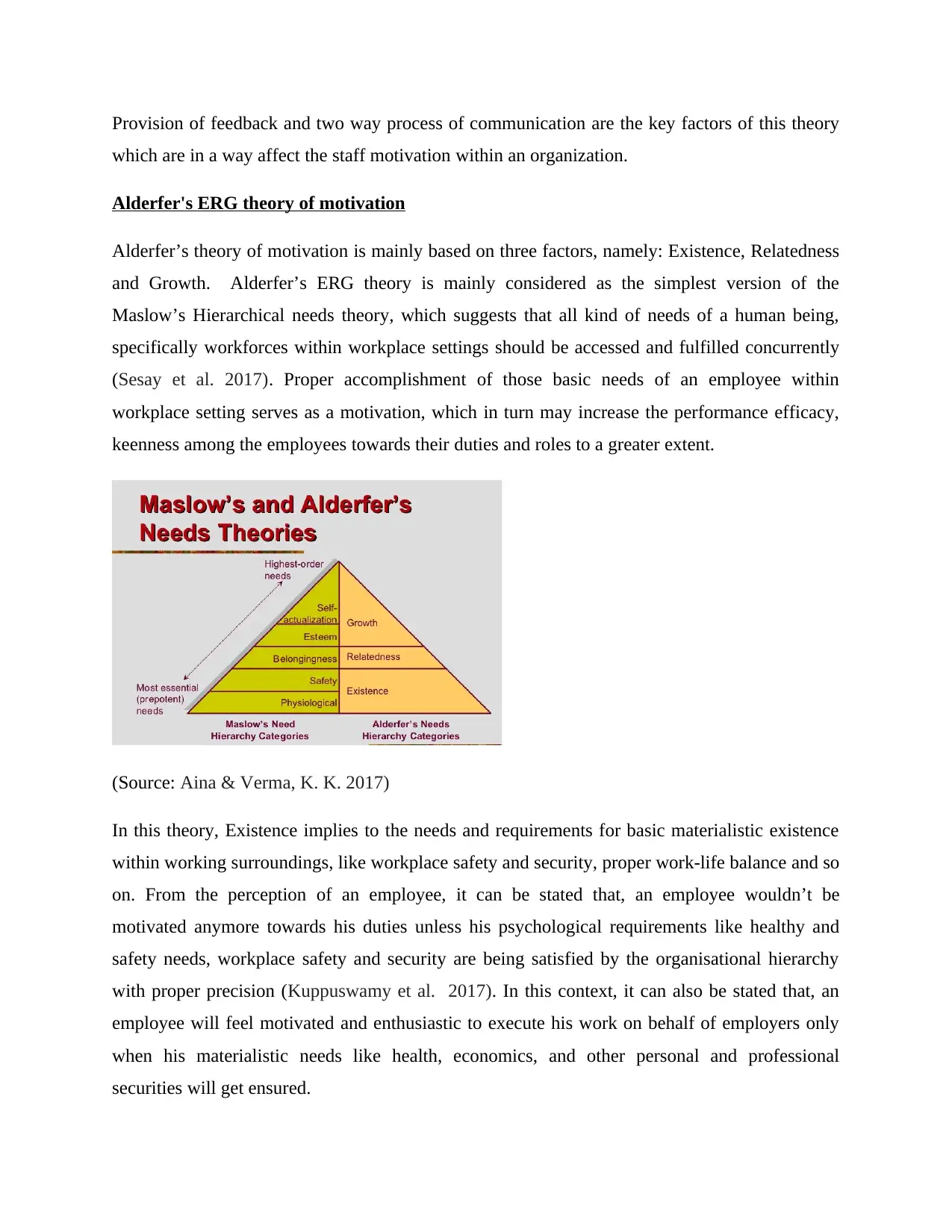
Provision of feedback and two way process of communication are the key factors of this theory
which are in a way affect the staff motivation within an organization.
Alderfer's ERG theory of motivation
Alderfer’s theory of motivation is mainly based on three factors, namely: Existence, Relatedness
and Growth. Alderfer’s ERG theory is mainly considered as the simplest version of the
Maslow’s Hierarchical needs theory, which suggests that all kind of needs of a human being,
specifically workforces within workplace settings should be accessed and fulfilled concurrently
(Sesay et al. 2017). Proper accomplishment of those basic needs of an employee within
workplace setting serves as a motivation, which in turn may increase the performance efficacy,
keenness among the employees towards their duties and roles to a greater extent.
(Source: Aina & Verma, K. K. 2017)
In this theory, Existence implies to the needs and requirements for basic materialistic existence
within working surroundings, like workplace safety and security, proper work-life balance and so
on. From the perception of an employee, it can be stated that, an employee wouldn’t be
motivated anymore towards his duties unless his psychological requirements like healthy and
safety needs, workplace safety and security are being satisfied by the organisational hierarchy
with proper precision (Kuppuswamy et al. 2017). In this context, it can also be stated that, an
employee will feel motivated and enthusiastic to execute his work on behalf of employers only
when his materialistic needs like health, economics, and other personal and professional
securities will get ensured.
which are in a way affect the staff motivation within an organization.
Alderfer's ERG theory of motivation
Alderfer’s theory of motivation is mainly based on three factors, namely: Existence, Relatedness
and Growth. Alderfer’s ERG theory is mainly considered as the simplest version of the
Maslow’s Hierarchical needs theory, which suggests that all kind of needs of a human being,
specifically workforces within workplace settings should be accessed and fulfilled concurrently
(Sesay et al. 2017). Proper accomplishment of those basic needs of an employee within
workplace setting serves as a motivation, which in turn may increase the performance efficacy,
keenness among the employees towards their duties and roles to a greater extent.
(Source: Aina & Verma, K. K. 2017)
In this theory, Existence implies to the needs and requirements for basic materialistic existence
within working surroundings, like workplace safety and security, proper work-life balance and so
on. From the perception of an employee, it can be stated that, an employee wouldn’t be
motivated anymore towards his duties unless his psychological requirements like healthy and
safety needs, workplace safety and security are being satisfied by the organisational hierarchy
with proper precision (Kuppuswamy et al. 2017). In this context, it can also be stated that, an
employee will feel motivated and enthusiastic to execute his work on behalf of employers only
when his materialistic needs like health, economics, and other personal and professional
securities will get ensured.
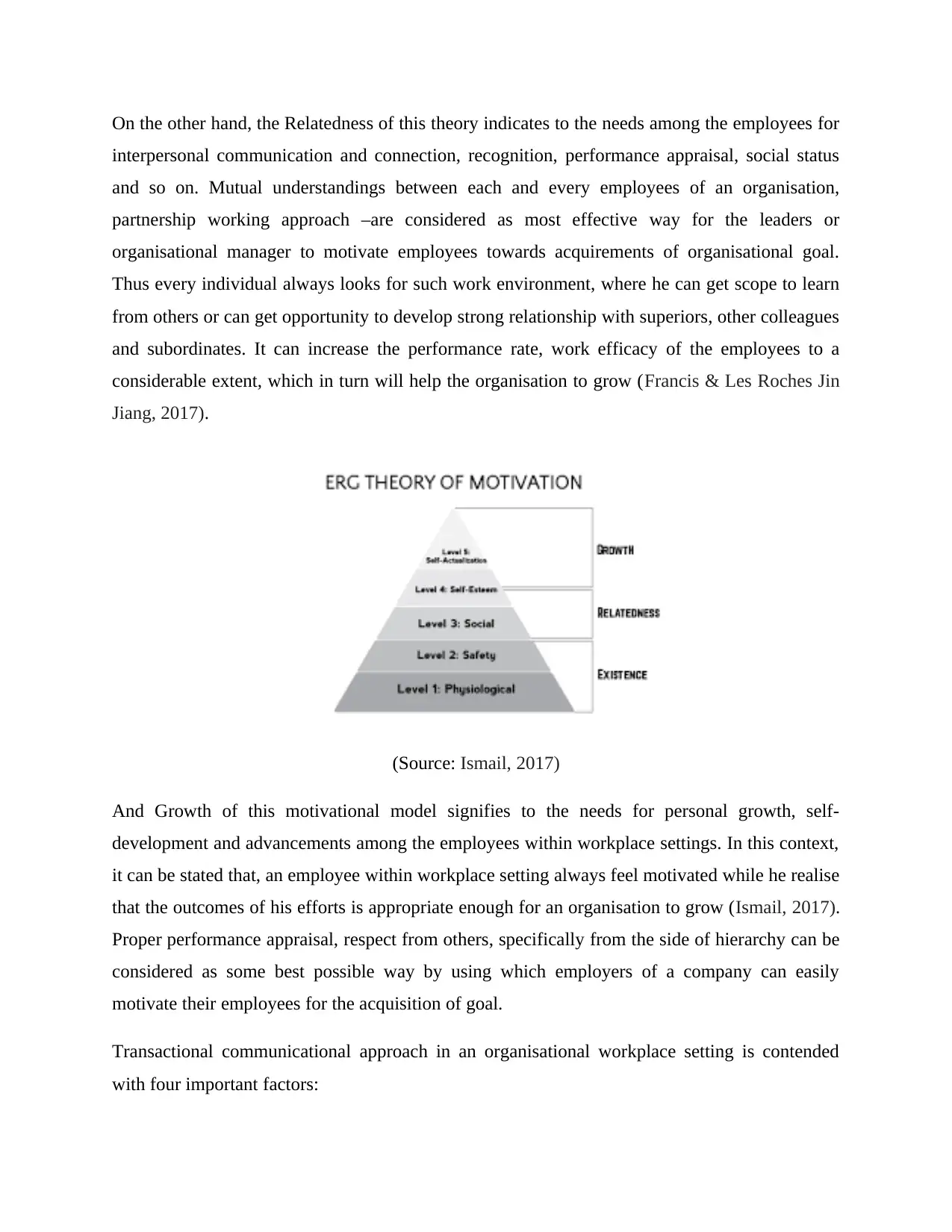
On the other hand, the Relatedness of this theory indicates to the needs among the employees for
interpersonal communication and connection, recognition, performance appraisal, social status
and so on. Mutual understandings between each and every employees of an organisation,
partnership working approach –are considered as most effective way for the leaders or
organisational manager to motivate employees towards acquirements of organisational goal.
Thus every individual always looks for such work environment, where he can get scope to learn
from others or can get opportunity to develop strong relationship with superiors, other colleagues
and subordinates. It can increase the performance rate, work efficacy of the employees to a
considerable extent, which in turn will help the organisation to grow (Francis & Les Roches Jin
Jiang, 2017).
(Source: Ismail, 2017)
And Growth of this motivational model signifies to the needs for personal growth, self-
development and advancements among the employees within workplace settings. In this context,
it can be stated that, an employee within workplace setting always feel motivated while he realise
that the outcomes of his efforts is appropriate enough for an organisation to grow (Ismail, 2017).
Proper performance appraisal, respect from others, specifically from the side of hierarchy can be
considered as some best possible way by using which employers of a company can easily
motivate their employees for the acquisition of goal.
Transactional communicational approach in an organisational workplace setting is contended
with four important factors:
interpersonal communication and connection, recognition, performance appraisal, social status
and so on. Mutual understandings between each and every employees of an organisation,
partnership working approach –are considered as most effective way for the leaders or
organisational manager to motivate employees towards acquirements of organisational goal.
Thus every individual always looks for such work environment, where he can get scope to learn
from others or can get opportunity to develop strong relationship with superiors, other colleagues
and subordinates. It can increase the performance rate, work efficacy of the employees to a
considerable extent, which in turn will help the organisation to grow (Francis & Les Roches Jin
Jiang, 2017).
(Source: Ismail, 2017)
And Growth of this motivational model signifies to the needs for personal growth, self-
development and advancements among the employees within workplace settings. In this context,
it can be stated that, an employee within workplace setting always feel motivated while he realise
that the outcomes of his efforts is appropriate enough for an organisation to grow (Ismail, 2017).
Proper performance appraisal, respect from others, specifically from the side of hierarchy can be
considered as some best possible way by using which employers of a company can easily
motivate their employees for the acquisition of goal.
Transactional communicational approach in an organisational workplace setting is contended
with four important factors:
⊘ This is a preview!⊘
Do you want full access?
Subscribe today to unlock all pages.

Trusted by 1+ million students worldwide
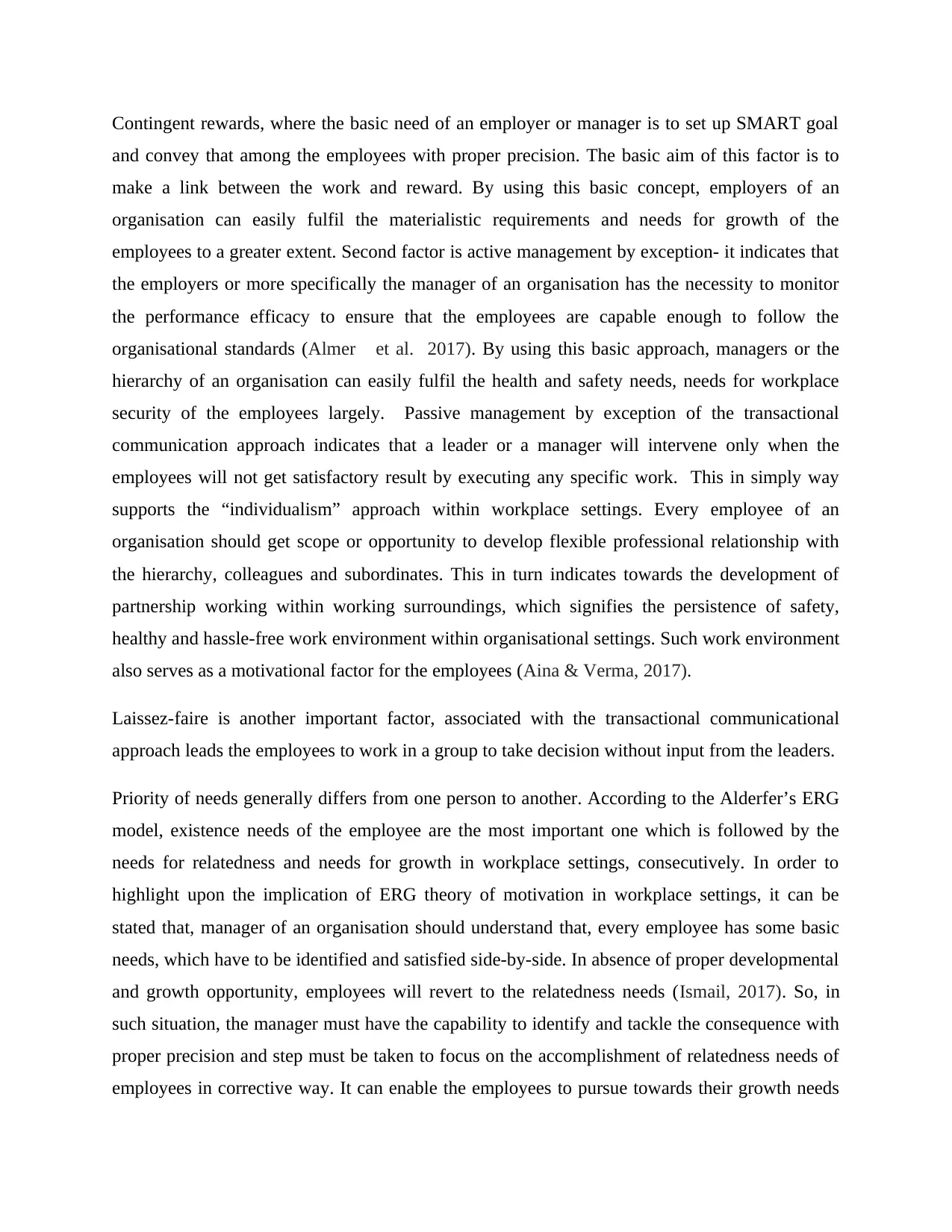
Contingent rewards, where the basic need of an employer or manager is to set up SMART goal
and convey that among the employees with proper precision. The basic aim of this factor is to
make a link between the work and reward. By using this basic concept, employers of an
organisation can easily fulfil the materialistic requirements and needs for growth of the
employees to a greater extent. Second factor is active management by exception- it indicates that
the employers or more specifically the manager of an organisation has the necessity to monitor
the performance efficacy to ensure that the employees are capable enough to follow the
organisational standards (Almer et al. 2017). By using this basic approach, managers or the
hierarchy of an organisation can easily fulfil the health and safety needs, needs for workplace
security of the employees largely. Passive management by exception of the transactional
communication approach indicates that a leader or a manager will intervene only when the
employees will not get satisfactory result by executing any specific work. This in simply way
supports the “individualism” approach within workplace settings. Every employee of an
organisation should get scope or opportunity to develop flexible professional relationship with
the hierarchy, colleagues and subordinates. This in turn indicates towards the development of
partnership working within working surroundings, which signifies the persistence of safety,
healthy and hassle-free work environment within organisational settings. Such work environment
also serves as a motivational factor for the employees (Aina & Verma, 2017).
Laissez-faire is another important factor, associated with the transactional communicational
approach leads the employees to work in a group to take decision without input from the leaders.
Priority of needs generally differs from one person to another. According to the Alderfer’s ERG
model, existence needs of the employee are the most important one which is followed by the
needs for relatedness and needs for growth in workplace settings, consecutively. In order to
highlight upon the implication of ERG theory of motivation in workplace settings, it can be
stated that, manager of an organisation should understand that, every employee has some basic
needs, which have to be identified and satisfied side-by-side. In absence of proper developmental
and growth opportunity, employees will revert to the relatedness needs (Ismail, 2017). So, in
such situation, the manager must have the capability to identify and tackle the consequence with
proper precision and step must be taken to focus on the accomplishment of relatedness needs of
employees in corrective way. It can enable the employees to pursue towards their growth needs
and convey that among the employees with proper precision. The basic aim of this factor is to
make a link between the work and reward. By using this basic concept, employers of an
organisation can easily fulfil the materialistic requirements and needs for growth of the
employees to a greater extent. Second factor is active management by exception- it indicates that
the employers or more specifically the manager of an organisation has the necessity to monitor
the performance efficacy to ensure that the employees are capable enough to follow the
organisational standards (Almer et al. 2017). By using this basic approach, managers or the
hierarchy of an organisation can easily fulfil the health and safety needs, needs for workplace
security of the employees largely. Passive management by exception of the transactional
communication approach indicates that a leader or a manager will intervene only when the
employees will not get satisfactory result by executing any specific work. This in simply way
supports the “individualism” approach within workplace settings. Every employee of an
organisation should get scope or opportunity to develop flexible professional relationship with
the hierarchy, colleagues and subordinates. This in turn indicates towards the development of
partnership working within working surroundings, which signifies the persistence of safety,
healthy and hassle-free work environment within organisational settings. Such work environment
also serves as a motivational factor for the employees (Aina & Verma, 2017).
Laissez-faire is another important factor, associated with the transactional communicational
approach leads the employees to work in a group to take decision without input from the leaders.
Priority of needs generally differs from one person to another. According to the Alderfer’s ERG
model, existence needs of the employee are the most important one which is followed by the
needs for relatedness and needs for growth in workplace settings, consecutively. In order to
highlight upon the implication of ERG theory of motivation in workplace settings, it can be
stated that, manager of an organisation should understand that, every employee has some basic
needs, which have to be identified and satisfied side-by-side. In absence of proper developmental
and growth opportunity, employees will revert to the relatedness needs (Ismail, 2017). So, in
such situation, the manager must have the capability to identify and tackle the consequence with
proper precision and step must be taken to focus on the accomplishment of relatedness needs of
employees in corrective way. It can enable the employees to pursue towards their growth needs
Paraphrase This Document
Need a fresh take? Get an instant paraphrase of this document with our AI Paraphraser
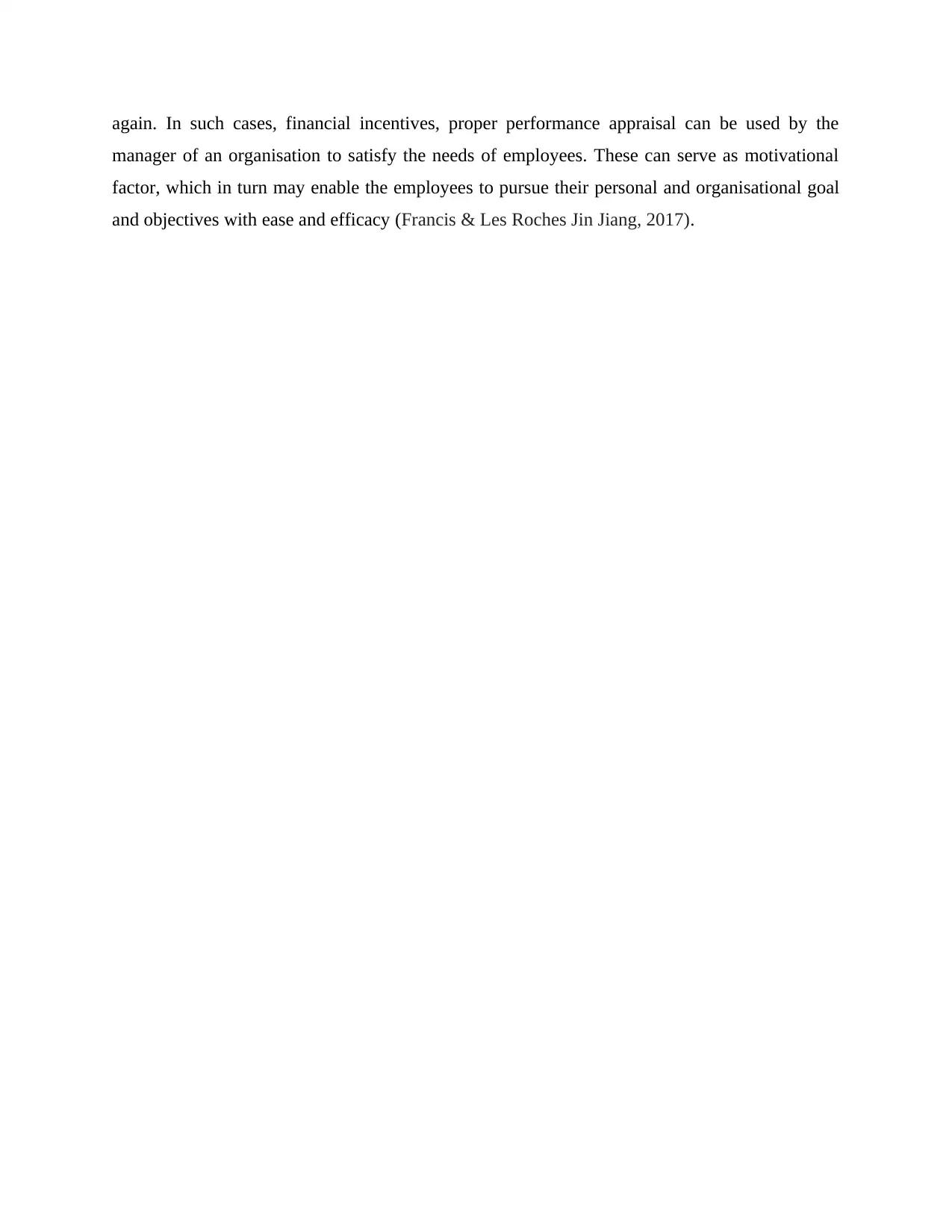
again. In such cases, financial incentives, proper performance appraisal can be used by the
manager of an organisation to satisfy the needs of employees. These can serve as motivational
factor, which in turn may enable the employees to pursue their personal and organisational goal
and objectives with ease and efficacy (Francis & Les Roches Jin Jiang, 2017).
manager of an organisation to satisfy the needs of employees. These can serve as motivational
factor, which in turn may enable the employees to pursue their personal and organisational goal
and objectives with ease and efficacy (Francis & Les Roches Jin Jiang, 2017).
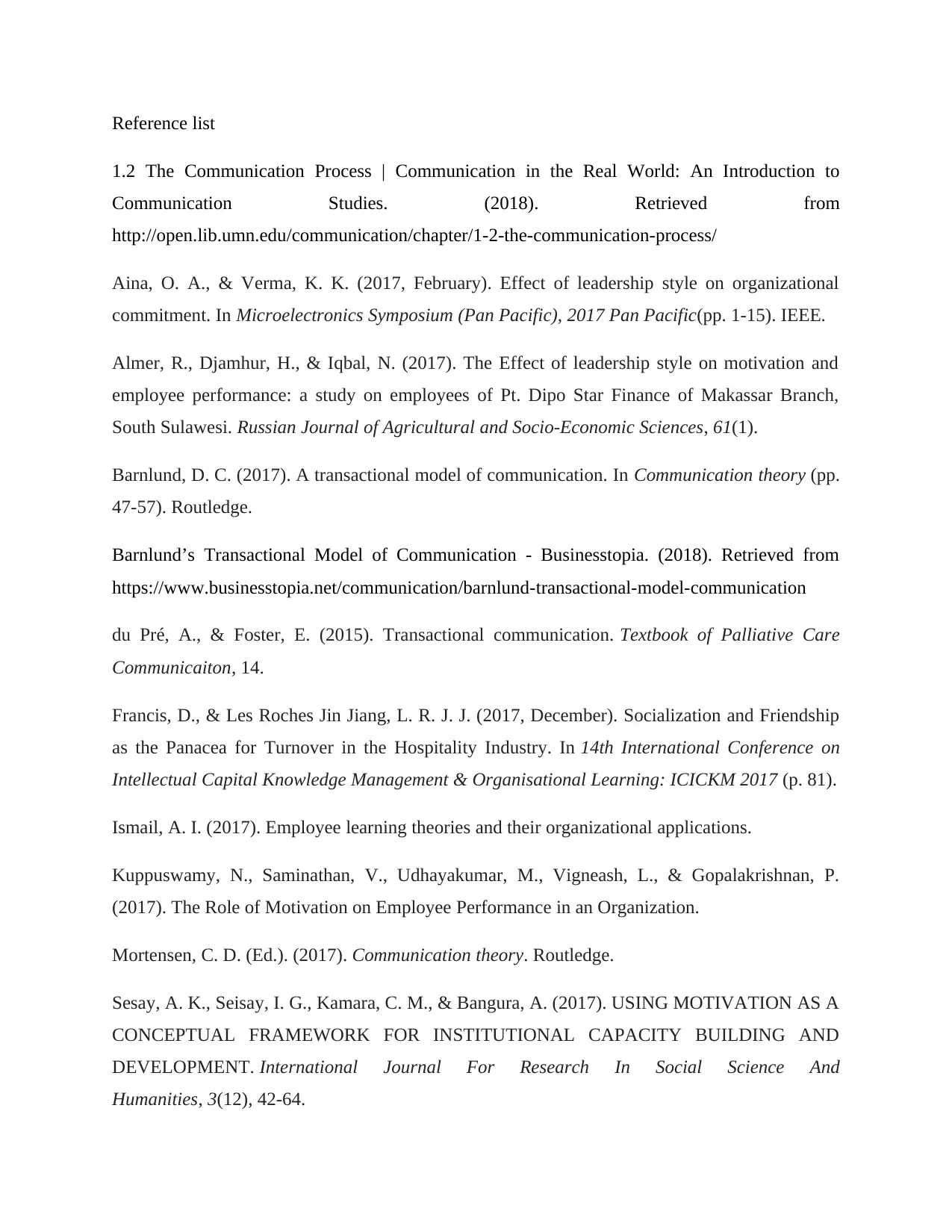
Reference list
1.2 The Communication Process | Communication in the Real World: An Introduction to
Communication Studies. (2018). Retrieved from
http://open.lib.umn.edu/communication/chapter/1-2-the-communication-process/
Aina, O. A., & Verma, K. K. (2017, February). Effect of leadership style on organizational
commitment. In Microelectronics Symposium (Pan Pacific), 2017 Pan Pacific(pp. 1-15). IEEE.
Almer, R., Djamhur, H., & Iqbal, N. (2017). The Effect of leadership style on motivation and
employee performance: a study on employees of Pt. Dipo Star Finance of Makassar Branch,
South Sulawesi. Russian Journal of Agricultural and Socio-Economic Sciences, 61(1).
Barnlund, D. C. (2017). A transactional model of communication. In Communication theory (pp.
47-57). Routledge.
Barnlund’s Transactional Model of Communication - Businesstopia. (2018). Retrieved from
https://www.businesstopia.net/communication/barnlund-transactional-model-communication
du Pré, A., & Foster, E. (2015). Transactional communication. Textbook of Palliative Care
Communicaiton, 14.
Francis, D., & Les Roches Jin Jiang, L. R. J. J. (2017, December). Socialization and Friendship
as the Panacea for Turnover in the Hospitality Industry. In 14th International Conference on
Intellectual Capital Knowledge Management & Organisational Learning: ICICKM 2017 (p. 81).
Ismail, A. I. (2017). Employee learning theories and their organizational applications.
Kuppuswamy, N., Saminathan, V., Udhayakumar, M., Vigneash, L., & Gopalakrishnan, P.
(2017). The Role of Motivation on Employee Performance in an Organization.
Mortensen, C. D. (Ed.). (2017). Communication theory. Routledge.
Sesay, A. K., Seisay, I. G., Kamara, C. M., & Bangura, A. (2017). USING MOTIVATION AS A
CONCEPTUAL FRAMEWORK FOR INSTITUTIONAL CAPACITY BUILDING AND
DEVELOPMENT. International Journal For Research In Social Science And
Humanities, 3(12), 42-64.
1.2 The Communication Process | Communication in the Real World: An Introduction to
Communication Studies. (2018). Retrieved from
http://open.lib.umn.edu/communication/chapter/1-2-the-communication-process/
Aina, O. A., & Verma, K. K. (2017, February). Effect of leadership style on organizational
commitment. In Microelectronics Symposium (Pan Pacific), 2017 Pan Pacific(pp. 1-15). IEEE.
Almer, R., Djamhur, H., & Iqbal, N. (2017). The Effect of leadership style on motivation and
employee performance: a study on employees of Pt. Dipo Star Finance of Makassar Branch,
South Sulawesi. Russian Journal of Agricultural and Socio-Economic Sciences, 61(1).
Barnlund, D. C. (2017). A transactional model of communication. In Communication theory (pp.
47-57). Routledge.
Barnlund’s Transactional Model of Communication - Businesstopia. (2018). Retrieved from
https://www.businesstopia.net/communication/barnlund-transactional-model-communication
du Pré, A., & Foster, E. (2015). Transactional communication. Textbook of Palliative Care
Communicaiton, 14.
Francis, D., & Les Roches Jin Jiang, L. R. J. J. (2017, December). Socialization and Friendship
as the Panacea for Turnover in the Hospitality Industry. In 14th International Conference on
Intellectual Capital Knowledge Management & Organisational Learning: ICICKM 2017 (p. 81).
Ismail, A. I. (2017). Employee learning theories and their organizational applications.
Kuppuswamy, N., Saminathan, V., Udhayakumar, M., Vigneash, L., & Gopalakrishnan, P.
(2017). The Role of Motivation on Employee Performance in an Organization.
Mortensen, C. D. (Ed.). (2017). Communication theory. Routledge.
Sesay, A. K., Seisay, I. G., Kamara, C. M., & Bangura, A. (2017). USING MOTIVATION AS A
CONCEPTUAL FRAMEWORK FOR INSTITUTIONAL CAPACITY BUILDING AND
DEVELOPMENT. International Journal For Research In Social Science And
Humanities, 3(12), 42-64.
⊘ This is a preview!⊘
Do you want full access?
Subscribe today to unlock all pages.

Trusted by 1+ million students worldwide

Watson, J., & Hill, A. (2015). Dictionary of media and communication studies. Bloomsbury
Publishing USA.
Publishing USA.
1 out of 10
Related Documents
Your All-in-One AI-Powered Toolkit for Academic Success.
+13062052269
info@desklib.com
Available 24*7 on WhatsApp / Email
![[object Object]](/_next/static/media/star-bottom.7253800d.svg)
Unlock your academic potential
Copyright © 2020–2025 A2Z Services. All Rights Reserved. Developed and managed by ZUCOL.




